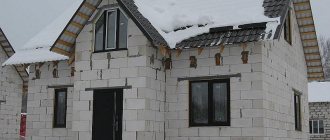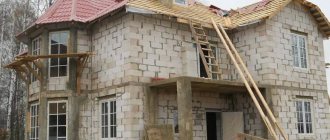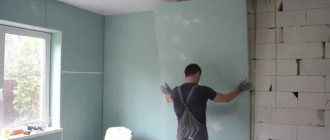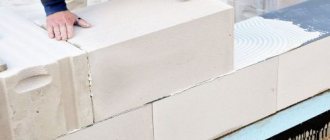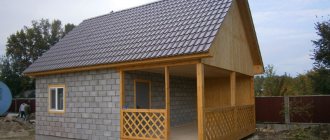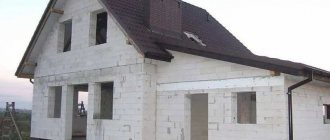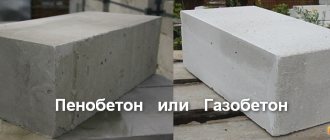Beton-House.com
Website about concrete: construction, characteristics, design. We combine the experience of professionals and private craftsmen in one place
Facade finishing option
Gas silicate block is a fairly popular material in the modern market of building materials for walls. This is primarily due to its availability to developers, supported by high quality indicators. The well-deserved prevalence of the gas silicate block is growing exponentially every year.
The process of building any house will sooner or later reach a stage when the pressing issue of finishing the facade will become the most pressing. In this article we will look for the answer.
So, what is the best way to cover the façade of a house with aerated concrete? Our instructions are about this.
How to decorate the outside of aerated concrete walls
- Installation of various types of siding
Why do you need to finish a gas block façade?
Aerated concrete is an artificial stone that belongs to the class of cellular concrete. It is created by mixing components such as cement, sand, lime, gypsum, and aluminum powder. The latter, when interacting with water, releases gas, which leads to the formation of bubbles in the structure of aerated concrete, as a result of which it becomes porous, or, as they say in the construction world, cellular.
Among the advantages of aerated concrete, due, among other things, to its cellular structure, one can highlight high thermal insulation properties, fire resistance and low weight. Thanks to these characteristics, it perfectly retains heat inside the house, protects it from fire and is quite easy to install.
However, porous concrete also has its disadvantages . The main one is hygroscopicity or the tendency to absorb water vapor from the air. In humid climatic conditions (be it rain, snow or fog), aerated concrete accumulates a large amount of moisture, which can lead to the appearance of fungus or mold, and a sharp drop in temperature can lead to cracks in the blocks and their subsequent destruction. Therefore, external finishing of aerated concrete walls with a material with good waterproofing properties is mandatory.
The ideal facade solution for an aerated concrete house
I already told you last year that the manufacturer of autoclaved aerated concrete, the YTONG company, launched a new product on the market - YTONG Decor decorative tiles. Initially, it was positioned only for internal use, but recently new TR (technical recommendations) were released, allowing the use of aerated concrete tiles when cladding building facades.
Thus, a very interesting solution has appeared on the market, allowing you to get a very cool and stylish façade at minimal cost. Let's take a closer look at what it looks like!
Finished facade made of brick tiles. Light and shadows add volume and this wall looks very cool. You wouldn’t even guess that these tiles are made of aerated concrete.
Aerated concrete tiles are available in 2 sizes: 75 and 50 mm wide. The length and thickness in both versions are the same: 250 and 10 mm, respectively. Tiles are supplied in cardboard boxes. Each contains a supply of tiles sufficient for cladding.
1 m² surface.
Almost any adhesive can be used to glue tiles to the wall surface. Both regular tile cement adhesive (or block adhesive) and polyurethane adhesive (spray foam) are suitable. That is, you can use almost any glue you have on hand. The simplest, fastest and most reliable option is polyurethane glue in cans.
You will also need super white cement putty. It is necessary at two stages. First to level the base of the wall, and then to subsequently paint the tiles.
A leveling layer of putty is first applied to the aerated concrete wall. It is necessary in order to obtain a uniform and even base, without seams and voids. Then the tiles are glued according to the established pattern. To fix the tiles until the glue has hardened, special reusable seam clamps are used.
After laying, all tiles are treated with a diluted solution of white cement putty.
In principle, everything is ready and can be left as is.
Or you can take special paint for mineral facades, tint it in the desired color and paint it with a roller. The result will be such beauty.
What can and cannot be used in decoration
The high hygroscopicity of aerated concrete requires compliance with certain rules when choosing cladding and carrying out finishing work. The main thing is to remember that for normal removal of moisture from the room, the vapor permeability of the walls must increase from the inside of the room to the outside, that is, the facade material must allow vapor to pass through well.
This requirement is met only by special finishing mixtures for gas and foam concrete. However, with the use of a ventilated facade, other options can be used, for example, porcelain stoneware, siding or stone.
What should never be used in decoration?
- ordinary sand-concrete plasters,
- film-forming paints,
- thin slabs of foamed polymers.
Such finishing blocks the pores for water to escape, which means it will lead to its retention and, as a result, a decrease in the strength of the coating and its thermal insulation properties.
Which method to choose for external cladding, what criteria to rely on
Cladding a house from the outside is much easier, since the list of acceptable materials is increasing.
The facing material must meet GOST; certain requirements apply to it. Since the wall is always outdoors, it is exposed to the elements. Precipitation will constantly fall on the material, and do not forget about UV radiation. Soft material quickly becomes unusable. Heavy workpieces are also not suitable.
Factors when choosing:
- durability;
- sound insulation;
- cost (per square meter);
- thermal insulation.
Ease of processing is also important. When work is done on a wall where there are ventilation holes, windows, doors, you often have to trim the workpiece. It’s good if this can be done without damaging property.
How to choose the right material?
When deciding which option is best for your aerated concrete home, there are a few key points to consider.
- Budget . You must assess your financial capabilities and determine the amount you are willing to spend on improving the façade of your home. At the same time, the main thing is not to forget about maintaining a balance between price and quality.
- Appearance . How important is home attractiveness to you? If choices are made based solely on aesthetics, functional properties may be overlooked or overshadowed. It is important not to forget about them, because the durability of the entire structure depends on the protective role of the façade finishing.
- Climate . Weather factors can have an extremely strong impact on the coating: lead to the formation of cracks, mold and even its destruction. Assess the temperature regime in your region: not only seasonal averages, but also maximum levels. It would be useful to add another 15-20% “reserve” to the latter, since climate change is presenting more and more surprises. In addition to temperature changes, it is important to take into account the amount of precipitation, humidity, windiness, and ultraviolet radiation.
It is also important to decide how you will install the cladding and whether you need external insulation. The best option would be to choose good quality vapor-permeable insulation and install a ventilated façade with a decorative coating to suit your taste and budget.
Let's consider specific materials, taking into account the indicated nuances.
- Coloring . The cheapest method, however, is not resistant to environmental factors. Whether it is heavy rains or intense sunlight, the brightness of the coating will decrease. It is also practically impossible to remove contaminants from a painted surface. All this makes it necessary to update it every few years.
- Plaster . It is important to choose those types that are suitable, first of all, for gas blocks, and secondly, for use in your climatic conditions (this information can be obtained from the markings on the packaging). Applying plaster requires certain skills, but if done correctly it will last 10-20 years. However, it requires periodic restoration.
- Brick . One of the most expensive options. It is difficult to install and creates a large load on the foundation, but if you follow the correct installation technique and high quality material, it will last until the house itself deforms.
- Ventilated facade . Provides good air circulation and moisture evaporation for aerated concrete walls. Will last more than 50 years, depending on the chosen decorative coating. It is easy to clean from dirt, and individual cladding elements can be replaced independently if damaged.
Buildings made of aerated concrete block: the whole truth about the material
First, let’s consider: how does aerated concrete differ from competitors with similar properties? To do this, let’s assume that our house has already been built and let’s try to look at it through the eyes of a practitioner who has independently gone through all the stages of construction.
It’s probably worth noting right away that the cost of building walls from this material will be very attractive, relative to, for example, brick, which cannot but please any homeowner. This is further supported by ease of use: the aerated block can be cut, sanded, and given the desired shape, without having any professional skills.
Moreover, non-autoclaved aerated concrete can be made independently.
If we consider the technical component, the advantages of a house built from aerated concrete blocks will be as follows:
- A low thermal conductivity coefficient will make the house warm;
- The ability of vapor permeation will provide a comfortable microclimate;
- Despite their low weight, aerated concrete blocks are strong enough to ensure a long service life;
- The gas block can withstand up to 35 cycles of freezing and thawing, and this does not take into account subsequent finishing, in which materials used for their intended purpose can extend their service life
- Good block geometry has a beneficial effect on construction time.
- An undoubted advantage is the non-flammability and environmental friendliness of the material.
Aerated block house
- All of the above advantages can be seen in advertising of goods from almost any manufacturer. And we will try to look at this impartially.
- Is the price really that low? Yes, indeed, if you do not take into account subsequent finishing, without which aerated concrete will darken over time and lose a lot of its positive properties. In this case, one compensates for the other.
- The ability to vapor permeability, frost resistance, thermal conductivity and other characteristics can retain their properties only in the case of technically correct finishing and using suitable materials.
- In order for aerated concrete to serve for a long time and its advantages not to turn into disadvantages, protective and decorative finishing should be approached with special responsibility.
How to decorate the facade of a house
Tips for finishing aerated concrete
How long can aerated concrete buildings be left unfinished?
First, let's consider the question of how long an aerated concrete house can last unfinished without losing its performance properties.
As we noted earlier, this type of concrete has a cellular structure, as a result of which it absorbs moisture well and also removes it well. Therefore, in the warm season, even in the presence of precipitation, it feels great - all the liquid from its surface simply evaporates.
Winter, on the contrary, can have a rather negative impact on aerated concrete. At temperatures above zero, the blocks become damp, and when it drops, the water that gets into the pores begins to solidify and leads to cracking and destruction of the material.
One winter season is unlikely to lead to a significant deterioration in the condition of the blocks, but you definitely shouldn’t delay the finishing work too much.
If you nevertheless decide to live in a gas-block house for several years without performing external finishing, the main thing is to take care of waterproofing the facade . One of the inexpensive and easy-to-implement methods is to treat the surface with a water-repellent impregnation - a water repellent. In addition to protecting against water penetration, it will also protect the front part of the building from the appearance of moss, efflorescence or mold.
Another simple option to ensure moisture protection is to apply 1-2 layers of primer followed by plastering.
When to install?
In the off-season, it is highly not recommended to install the cladding, since all accumulated moisture from the surface of the house does not evaporate, and the applied external coating will only reduce the vapor permeability of the walls. Therefore, the best choice for this would be the summer.
Regarding the completion of the construction of the building, it is considered optimal to begin external finishing work after six months. During this time, the bulk of the moisture from the gas blocks will disappear, and therefore, the likelihood of their shrinkage and the appearance of cracks will be minimized.
When using paint or plaster for façade coating, it is necessary to first carry out the interior finishing of the room, since some of its stages involve increased water evaporation. If you use ventilated facade technology, you can start with the outer cladding.
Important! If you are the first to carry out exterior finishing work, be sure to carry it out outside the heating season.
In conclusion , I would like to note that the exterior decoration of a house made of aerated concrete is an essential condition for its long service life, and in its absence, the material will lose most of its advantages over other options for building construction and will begin to collapse under the influence of external factors.
Exterior finishing options for a single-layer aerated concrete wall
The following are recommended for exterior finishing of a single-layer wall made of aerated concrete or gas silicate:
- Any hinged ventilated facades covered with decorative panels, siding, lining;
- Facing with facing bricks with an air (preferably ventilated) gap of 30-50 mm. between brick and block masonry;
- Plastering with special light plaster mixtures for aerated concrete;
- Thin-layer (3-5 mm) plaster (putty) with special compounds for aerated concrete;
- Painting the wall with textured façade vapor-permeable paints or putties. Preparing the wall for painting can be done in two ways: with grouting the masonry joints or with imitation of grouting the joints of masonry blocks.
Portfolio
Porcelain tile facade of the Tikhoretsky shopping center
Facade area – 855 m2
Work completion time: 60 calendar days
Ventilated facade of the school “Integration XXI Century”
Facade area – 700 m2
Work completion time: 50 calendar days
Dye
You can consider the option of painting the walls. The paint should be selected responsibly and ask the sellers in advance whether it is possible to paint an aerated concrete wall with high quality. Also take into account the air temperature, since in the cold season it is unlikely that you will be able to paint well.
It is also worth worrying about surface preparation. All roughness, glue residues from other work, and cracks should be removed. A well-prepared surface is half the effort towards success. Don’t expect that your wall will look great after the first coat; you need to paint it in several layers.
You can paint on a plastered surface, but this is not necessary. In this case, for better adhesion, it is necessary to apply a primer coating in several layers.
If you still decide to plaster before painting, it is important to use a special mesh and control the thickness of the plaster layer.
